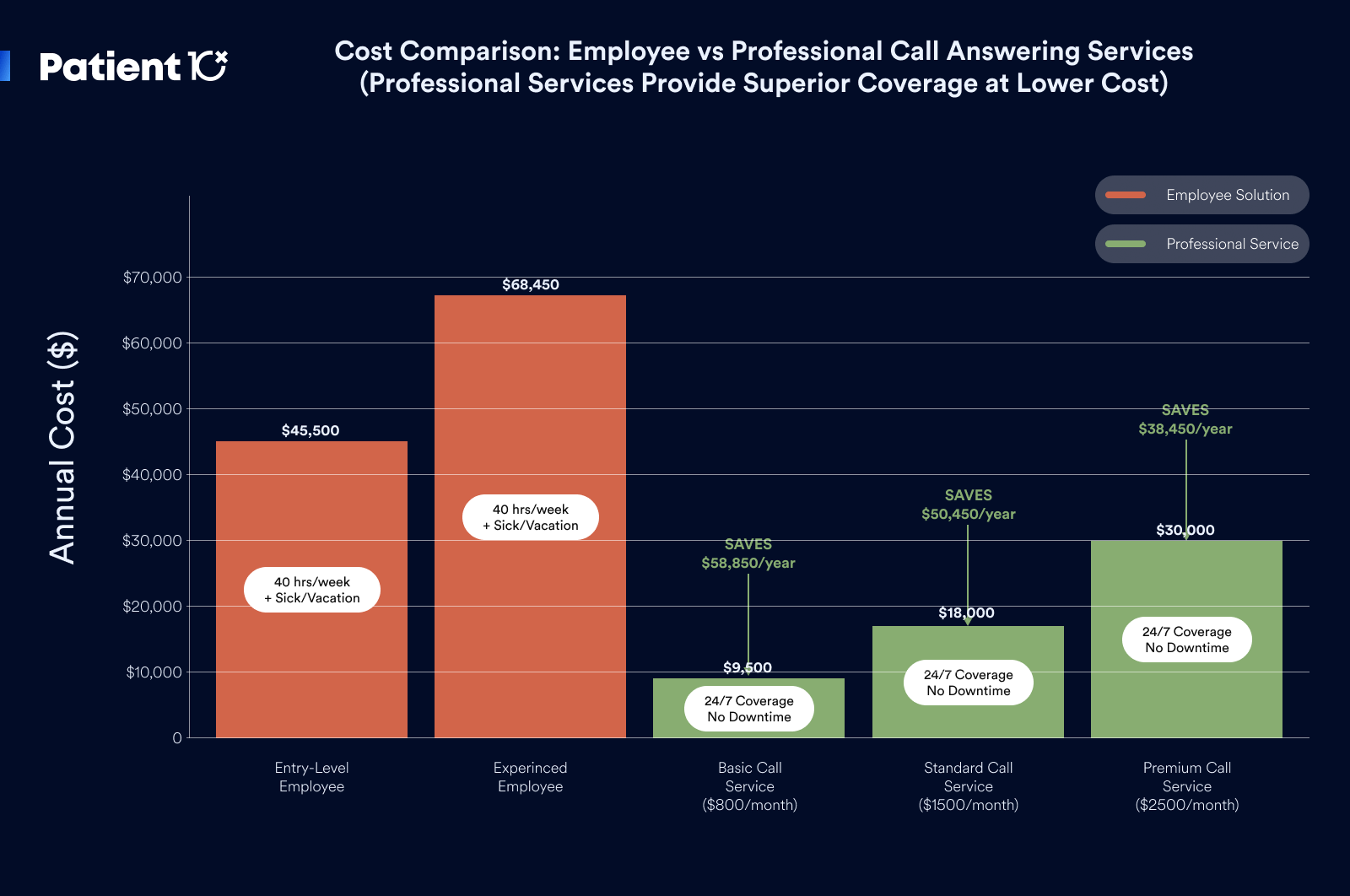Complete cost analysis of hiring staff vs. outsourcing medical practice phone coverage. Discover hidden employment costs, ROI calculations, and why professional call answering delivers superior value.

Medical practice administrators face a critical decision when addressing phone coverage challenges: hire additional staff to handle call volume or outsource to professional call answering services. While the surface-level comparison might suggest that hiring employees provide better value, comprehensive financial analysis reveals hidden costs and operational complexities that often make outsourcing the more cost-effective and reliable solution.
The true cost of employment in medical practices extends far beyond base salary to include benefits, payroll taxes, training, management overhead, and the substantial hidden costs of turnover, sick leave, and performance variability. When these factors are properly calculated, the annual cost of a full-time receptionist or phone coordinator typically ranges from $45,000 to $65,000, with additional indirect costs that can push total employment expenses to $70,000-$85,000 annually.

Professional medical call answering services, by contrast, typically cost $800-$2,500 monthly ($9,600-$30,000 annually) while providing superior coverage, professional training, and guaranteed performance levels that eliminate the operational risks associated with employee management. This cost differential, combined with enhanced service quality and operational reliability, creates a compelling return on investment for practices seeking optimal phone coverage solutions.

Understanding the complete financial picture requires examining not only direct costs but also opportunity costs, risk factors, and performance outcomes that influence long-term practice success. Medical practices that conduct thorough cost-benefit analysis typically discover that professional call answering services provide superior value while eliminating the management complexity and operational risks associated with employee-based phone coverage.
Base Salary and Wage Considerations
Entry-level medical receptionist positions typically command $28,000-$38,000 annually in most markets, with experienced phone coordinators earning $35,000-$45,000 depending on geographic location and practice specialty. However, these base salary figures represent only the foundation of total employment costs, with numerous additional expenses that significantly increase the true cost of employment.
Geographic variations in healthcare employment costs create substantial differences in total compensation requirements. Urban markets typically require 20-40% higher salaries compared to rural areas, with major metropolitan areas like New York, Los Angeles, and San Francisco demanding $40,000-$55,000 for experienced medical phone staff. These geographic premiums reflect both cost-of-living differences and competitive employment markets for skilled healthcare support staff.
Specialty practices often require higher compensation levels due to the increased complexity of patient communications, medical terminology requirements, and emergency response protocols. Surgical practices, cardiology offices, and other specialty environments typically pay 10-20% premiums for phone staff with relevant experience and specialized knowledge.
The competitive healthcare employment market creates ongoing pressure for salary increases, with annual raises of 3-5% typical for retained employees. Practices that fail to provide competitive compensation often experience high turnover rates that dramatically increase total employment costs through recruitment, training, and productivity loss during transition periods.
Benefits and Payroll Tax Obligations
Employee benefits represent 25-35% of base salary costs for most medical practices, including health insurance, dental coverage, retirement contributions, and paid time off. A receptionist earning $35,000 annually typically requires an additional $8,750-$12,250 in benefits costs, bringing total compensation to $43,750-$47,250 before considering payroll taxes and other employment expenses.
Health insurance costs for medical practice employees have increased dramatically, with employer contributions typically ranging from $4,800-$8,400 annually for individual coverage and $12,000-$18,000 for family plans. Many practices find that health insurance costs alone represent 15-25% of total employee compensation, creating substantial financial obligations that extend far beyond base salary.
Payroll taxes, including Social Security, Medicare, unemployment insurance, and workers' compensation, add approximately 10-12% to total employment costs. These mandatory expenses cannot be reduced or eliminated, representing fixed costs that apply regardless of employee performance or productivity levels.
Paid time off, including vacation days, sick leave, and holidays, typically represents 15-20 additional working days annually, requiring either temporary coverage or reduced phone service during employee absences. The cost of PTO includes both continued salary payments and the operational impact of reduced coverage during peak periods.
Training and Onboarding Expenses
New employee training for medical practice phone coverage typically requires 40-80 hours of intensive instruction covering practice procedures, medical terminology, emergency protocols, and patient communication standards. The direct cost of training includes trainer time, reduced productivity during the learning period, and materials or system access required for comprehensive preparation.
Training costs typically range from $2,000-$4,000 per new employee when accounting for trainer salaries, reduced productivity, and the learning curve period during which new staff operates at reduced efficiency. Specialty practices with complex procedures or extensive patient protocols often require 80-120 hours of training, increasing costs to $4,000-$6,000 per new hire.
The opportunity cost of training includes the diversion of experienced staff from productive activities to training responsibilities, creating temporary reductions in overall practice efficiency. Senior staff members who provide training typically earn $20-$30 hourly, making their time investment a significant component of total training costs.
Ongoing training requirements for regulatory compliance, system updates, and skill development add $500-$1,500 annually per employee. Medical practices must maintain current training on HIPAA compliance, emergency procedures, and evolving practice management systems to ensure consistent service quality and regulatory compliance.
Turnover Costs and Replacement Expenses
Healthcare support staff turnover rates typically range from 20-40% annually, with phone-intensive positions experiencing higher turnover due to stress, workload demands, and limited career advancement opportunities. Each turnover event creates substantial costs, including recruitment, training, and productivity loss during transition periods.
Recruitment costs for medical practice phone staff typically range from $1,500-$3,500 per position, including advertising expenses, background checks, interview time, and administrative processing. Practices in competitive markets or those requiring specialized experience often face higher recruitment costs and longer hiring timelines.
The productivity impact of turnover extends beyond the departing employee to include reduced efficiency among remaining staff who must cover additional responsibilities during transition periods. This coverage typically reduces overall practice efficiency by 15-25% for 4-8 weeks during the recruitment and training of replacement staff.
Lost institutional knowledge represents a hidden cost of turnover that proves difficult to quantify but significantly impacts service quality and efficiency. Experienced phone staff develop detailed understanding of practice procedures, physician preferences, and patient relationships that cannot be quickly replicated by new employees.
Management and Supervision Overhead
Employee management requires ongoing investment in supervision, performance monitoring, scheduling coordination, and administrative support that adds 15-25% to total employment costs. Practice managers typically spend 2-4 hours weekly on phone staff supervision, representing $2,000-$4,000 annually in management overhead.
Performance management, including regular reviews, goal setting, and corrective action procedures, requires additional administrative time and documentation. Poor-performing employees often require intensive management intervention that can consume 5-10 hours weekly of management time, dramatically increasing the true cost of employment.
Scheduling coordination for phone coverage becomes increasingly complex with multiple employees, requiring careful management of vacation time, sick leave, and shift coverage. The administrative burden of employee scheduling typically requires 1-2 hours weekly of management time, adding $1,000-$2,000 annually to total employment costs.
Human resources compliance, including documentation, policy enforcement, and regulatory adherence, creates additional administrative requirements that increase with each employee. Practices with multiple phone staff often require dedicated HR support or external HR services that add $1,500-$3,000 annually to total employment costs.